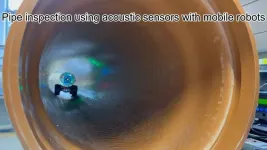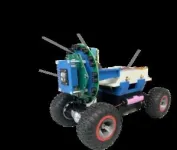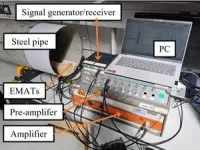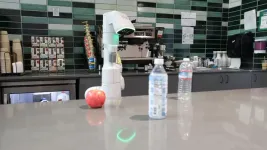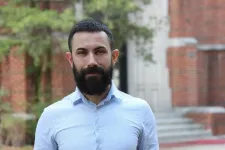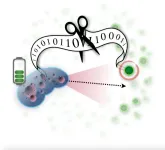(Press-News.org)
An inspection design method and procedure by which mobile robots can inspect large pipe structures has been demonstrated with the successful inspection of multiple defects on a three-meter long steel pipe using guided acoustic wave sensors.
The University of Bristol team, led by Professor Bruce Drinkwater and Professor Anthony Croxford, developed approach was used to review a long steel pipe with multiple defects, including circular holes with different sizes, a crack-like defect and pits, through a designed inspection path to achieve 100% detection coverage for a defined reference defect.
In the study, published today in NDT and E International, they show how they were able to effectively examine large plate-like structures using a network of independent robots, each carrying sensors capable of both sending and receiving guided acoustic waves, working in pulse-echo mode.
This approach has the major advantage of minimizing communication between robots, requires no synchronization and raises the possibility of on-board processing to lower data transfer costs and hence reducing overall inspection expenses. The inspection was divided into a defect detection and a defect localization stage.
Lead author Dr Jie Zhang explained: “There are many robotic systems with integrated ultrasound sensors used for automated inspection of pipelines from their inside to allow the pipeline operator to perform required inspections without stopping the flow of product in the pipeline. However, available systems struggle to cope with varying pipe cross-sections or network complexity, inevitably leading to pipeline disruption during inspection. This makes them suitable for specific inspections of high value assets, such as oil and gas pipelines, but not generally applicable.
“As the cost of mobile robots has reduced over recent years, it is increasingly possible to deploy multiple robots for a large area inspection. We take the existence of small inspection robots as its starting point, and explore how they can be used for generic monitoring of a structure. This requires inspection strategies, methodologies and assessment procedures that can be integrated with the mobile robots for accurate defect detection and localization that is low cost and efficient.
“We investigate this problem by considering a network of robots, each with a single omnidirectional guided acoustic wave transducer. This configuration is considered as it is arguably the simplest, with good potential for integration in a low cost platform.”
The methods employed are generally applicable to other related scenarios and allow the impact of any detection or localization method decisions to be quickly quantified. The methods could be used across other materials, pipe geometries, noise levels or guided wave modes, allowing the full range of sensor performance parameters, defects sizes and types and operating modalities to be explored. Also the techniques can be used to assess the detection and localization performance for specified inspection parameters, for example, predict the minimum detectable defect under a specified probability of detection and probability of false alarm.
The team will now investigate collaboration opportunities with industries to advance current prototypes for actual pipe inspections. This work is funded by the UK's Engineering and Physical Sciences Research Council (EPSRC) as a part of the Pipebots project.
Paper:
‘Pipe inspection using guided acoustic wave sensors integrated with mobile robots’ by Jie Zhang, Xudong Niu, Anthony J. Croxford, and Bruce W. Drinkwater in NDT and E International.
END
Modern robots know how to sense their environment and respond to language, but what they don’t know is often more important than what they do know. Teaching robots to ask for help is key to making them safer and more efficient.
Engineers at Princeton University and Google have come up with a new way to teach robots to know when they don’t know. The technique involves quantifying the fuzziness of human language and using that measurement to tell robots when to ask for further directions. Telling a robot to pick ...
Michele Galizia, a President’s Associates Presidential Professor in the School of Sustainable Chemical, Biological and Materials Engineering at the University of Oklahoma, is leading a research team that recently received a grant from the U.S. Department of Energy that will develop improved polymer membranes to advance molecular separation and related materials science.
“We currently separate chemicals, gases and liquids using a thermal-based distillation technology that is very expensive to operate and consumes the equivalent of eight GJ of electricity per person on the planet per year,” ...
Living systems—unlike non-living or inanimate objects—use information about their surrounding environment to survive. But not all information from the environment is meaningful or relevant for survival. The subset of information that is meaningful, and perhaps necessary for being alive, is called semantic information.
In a new paper published in PRX Life, University of Rochester physicists and their coauthors have, for the first time, applied this theory of semantic information to a well-known ...
Researchers have identified a new way to screen genes that cause several different types of cancers to grow, identifying particularly promising targets for precision oncology in oral and esophageal squamous cancers.
The study, published in this month’s issue of Cell Reports, used 3-dimensional models of organ tissues called organoids to identify and test potential gene targets from The Cancer Genome Atlas.
“There’s a tremendous amount of data in The Cancer Genome Atlas, ...
Over the past decades, increasing evidences have demonstrated that five retinoids, including retinol (ROL), retinol acetate (RAc), retinol propionate (RP), retinol palmitate (RPalm), and hydroxypinacolone retinoate (HPR), can be potential therapeutic agents for skin photoaging. However, therapeutic efficacies and biosafety have never been compared to these compounds. This study aimed to determine the optimal retinoid type(s) for anti-photoaging therapy both in vitro and in vivo.
The data demonstrated that four retinoids (RPalm, RP, HPR and ROL) but not RAc were effective for anti-photoaging treatment at 5 μg/mL in vitro, with action mechanisms associated with antioxidative, ...
As more medications move toward federal approval for Alzheimer’s disease, a new study led by researchers at UC San Francisco and Kaiser Permanente Washington has found that personalized health and lifestyle changes can delay or even prevent memory loss for higher-risk older adults.
The two-year study compared cognitive scores, risk factors and quality of life among 172 participants, of whom half had received personalized coaching to improve their health and lifestyle in areas believed to raise the risk of Alzheimer’s, such as uncontrolled diabetes and physical inactivity. These participants were ...
November 28, 2023-- Inadequate health coverage is a particular problem for commercially insured children, according to a new study released by Columbia University Mailman School of Public Health. The research shows that coverage gaps are affecting publicly insured children as well. Until now, prior research had focused on documenting rates and trends in insurance consistency for children covered by all insurance types. The findings are published in JAMA Health Forum.
“While uninsurance among children has generally been declining in the U.S., our results highlight the need for a renewed focus on making sure that children’s ...
DETROIT – A Wayne State University College of Engineering professor has received a $2.65 million award from the National Institute of Diabetes and Digestive and Kidney Diseases of the National Institutes of Health to develop a novel filtration platform to improve an advanced drug delivery device to optimize diabetes insulin treatments.
Subcutaneous insulin administration (SIA) technology has improved significantly over the past two decades, but SIA technology failure and underlying tissue damage caused by insulin phenolic preservatives ...
ROCHESTER, Minn. — Mayo Clinic’s Board of Trustees has approved Bold. Forward. Unbound. in Rochester, a multiyear strategic initiative that advances Mayo Clinic’s Bold. Forward. strategy to Cure, Connect and Transform healthcare for the benefit of patients everywhere. It reimagines Mayo Clinic’s downtown Rochester campus and introduces new facilities with a combination of innovative care concepts and digital technologies that will give Mayo Clinic the ability to scale transformation ...
While doctors and nurses were hailed as the frontline heroes of the COVID-19 pandemic, their counterparts in public health were experiencing threats. During the pandemic, threats against public health workers reached an all-time high. After the vaccine was released, those threats increased and changed in nature, according to a longitudinal study conducted during the first year of the pandemic by Jennifer Horney, founder of the University of Delaware Epidemiology Program in the College of Health Sciences.
The results, recently published in an open-access commentary in Public Health in Practice, show a strong need for expanded legal protections ...
